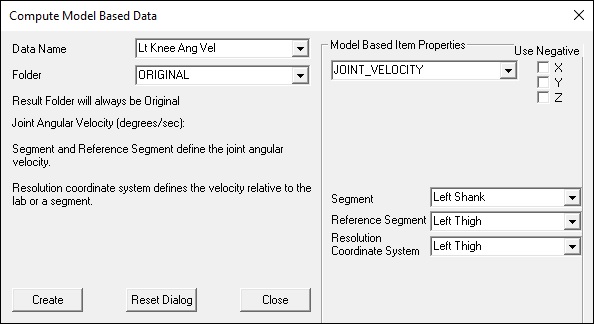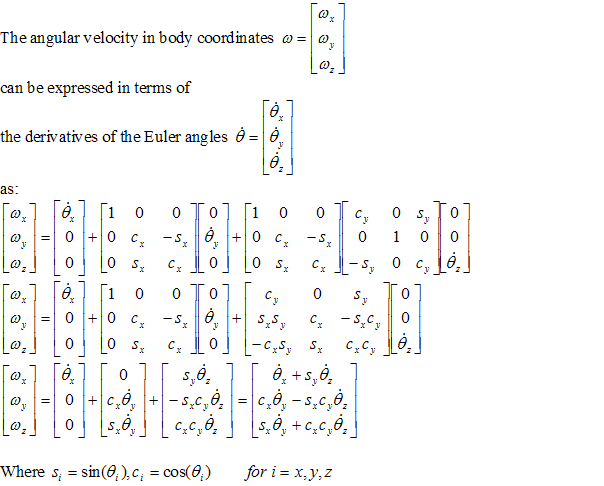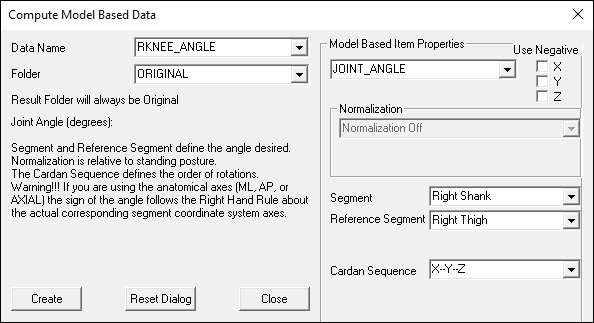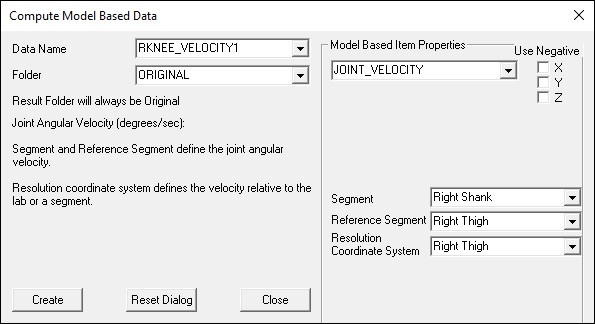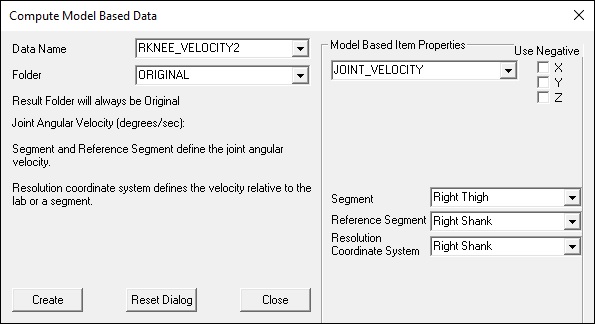Joint Velocity: Difference between revisions
No edit summary |
(Revised the example with the objective of clarity.) |
||
| Line 1: | Line 1: | ||
The | The Joint Velocity model-based item is a vector that describes the relative angular velocity of one segment relative to another segment. | ||
[[File:JointVelocityDlg.jpg]] | [[File:JointVelocityDlg.jpg]] | ||
| Line 8: | Line 6: | ||
<b>Relationship between the Joint Angular Velocity and the derivative of the Cardan Joint Angles</b> | <b>Relationship between the Joint Angular Velocity and the derivative of the Cardan Joint Angles</b> | ||
The Joint | The Joint Velocity can be a bit troublesome to interpret unless you recognize that the signal is not the same as the derivative of the Joint Angle. It is possible that the some terms of the Joint Velocity are not consistent with the derivative of the Joint Angle. Euler angles are not vectors, so it isn't possible to compute joint angular velocity by taking the first derivative of the joint angles (e.g. Euler/Cardan angles). | ||
Euler angles are not vectors, so it isn't possible to compute joint angular velocity by taking the first derivative of the joint angles (e.g. Euler/Cardan angles). | |||
With respect to the default Visual3D convention of an XYZ sequence for the Cardan angle, the joint angular velocity can be expressed in Euler angles using the following relationship. | With respect to the default Visual3D convention of an XYZ sequence for the Cardan angle, the joint angular velocity can be expressed in Euler angles using the following relationship. | ||
| Line 18: | Line 14: | ||
==Example - Comparing Joint Angle and Joint Angular Velocity== | ==Example - Comparing Joint Angle and Joint Angular Velocity== | ||
Joint Angles are typically represented in a Cardan | Joint Angles are typically represented in a Cardan sequence and Joint Velocities are typically represented as vectors. The consequence is that you cannot compare directly all 3 components of the Joint Angle with, what appear to be homologous, components of the Joint Velocity. For example, given the following definition of the Right Knee Angle: | ||
The consequence is that you cannot compare directly all 3 components of the Joint Angle with, what appear to be homologous, components of the Joint | |||
[[File:RKneeAngleDefn.jpg]] | [[File:RKneeAngleDefn.jpg]] | ||
and the following definition of the Right Knee Angular Velocity | and the following definition of the Right Knee Angular Velocity: | ||
[[File:RKneeVelocityDefn1.jpg]] | [[File:RKneeVelocityDefn1.jpg]] | ||
only the X-components of the two signals are related (e. | only the X-components of the two signals are related (i.e., these components relate to the segment's rotation about the same axis). | ||
If a second | If a second Joint Velocity item is created as follows: | ||
[[File:RKneeVelocityDefn2.jpg]] | [[File:RKneeVelocityDefn2.jpg]] | ||
then the Z-components of this second definition and the original joint angle definition can be compared. | |||
If the Y-component (the 2nd component) of the knee angle is small it is often referred to as ab/adduction, but it is important to note that this rotation is technically isn't about either the y-axis of the thigh or shank segments. If this Joint Angle Y-component isn't small then it is not really possible to compare the Y-components between the Joint Angle and Joint Velocity items. | |||
[[Category:Kinematics]] | [[Category:Kinematics]] | ||
[[Category:Joint_Angle]] | [[Category:Joint_Angle]] | ||
Latest revision as of 20:12, 11 April 2024
The Joint Velocity model-based item is a vector that describes the relative angular velocity of one segment relative to another segment.
Relationship between the Joint Angular Velocity and the derivative of the Cardan Joint Angles
The Joint Velocity can be a bit troublesome to interpret unless you recognize that the signal is not the same as the derivative of the Joint Angle. It is possible that the some terms of the Joint Velocity are not consistent with the derivative of the Joint Angle. Euler angles are not vectors, so it isn't possible to compute joint angular velocity by taking the first derivative of the joint angles (e.g. Euler/Cardan angles).
With respect to the default Visual3D convention of an XYZ sequence for the Cardan angle, the joint angular velocity can be expressed in Euler angles using the following relationship.
Example - Comparing Joint Angle and Joint Angular Velocity
Joint Angles are typically represented in a Cardan sequence and Joint Velocities are typically represented as vectors. The consequence is that you cannot compare directly all 3 components of the Joint Angle with, what appear to be homologous, components of the Joint Velocity. For example, given the following definition of the Right Knee Angle:
and the following definition of the Right Knee Angular Velocity:
only the X-components of the two signals are related (i.e., these components relate to the segment's rotation about the same axis).
If a second Joint Velocity item is created as follows:
then the Z-components of this second definition and the original joint angle definition can be compared.
If the Y-component (the 2nd component) of the knee angle is small it is often referred to as ab/adduction, but it is important to note that this rotation is technically isn't about either the y-axis of the thigh or shank segments. If this Joint Angle Y-component isn't small then it is not really possible to compare the Y-components between the Joint Angle and Joint Velocity items.
